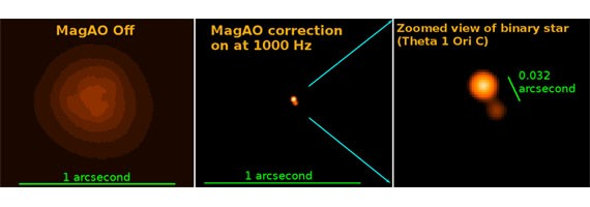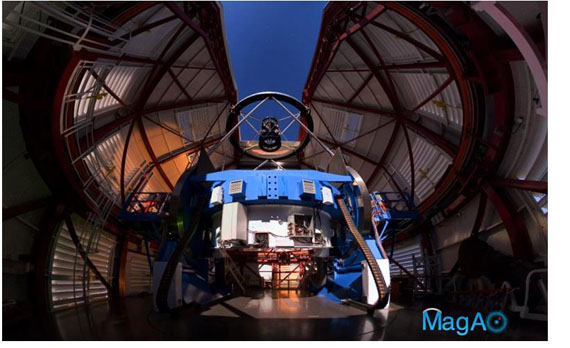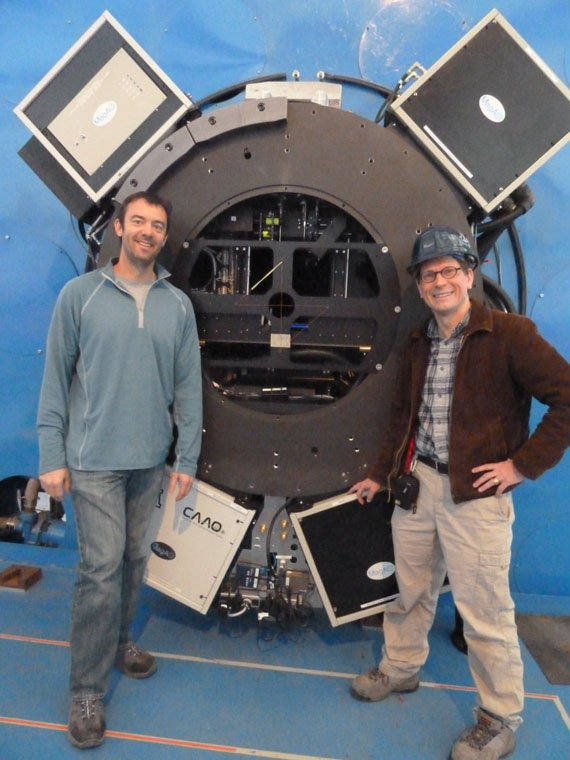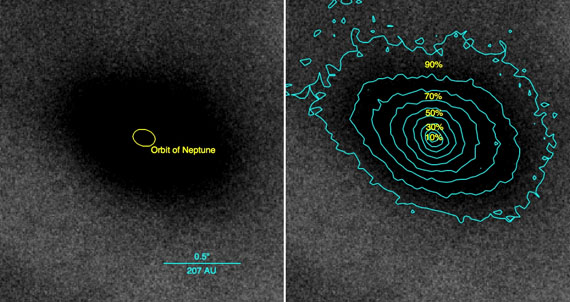
Scientists Make Highest Resolution Photos Ever of the Night Sky
Astronomers at the University of Arizona, Arcetri Observatory in Italy, and at the Carnegie Observatory have developed a new type of camera that allows higher resolution (sharper) images to be taken than ever before. The team has been developing this technology for over 20 years at observatories in Arizona (most recently at the Large Binocular Telescope; LBT), and has now deployed the latest version of these cameras in the high desert of Chile at the Magellan 6.5m (21ft) telescope. “It was very exciting to see this new camera make the night sky look sharper than has ever before been possible” said University of Arizona professor Laird Close, the project’s principal scientist, “We can, for the first time, make deep images that resolve objects just 0.02 arcseconds across. That is a very small angle on the sky. It is like the width of a dime (1.7 cm) seen over 100 miles (160 km) away. It could also be compared to resolving a baseball diamond on the Moon”.
Removing the “twinkle” From the Stars in Visible Light
The reason for the factor of 2 improvement over past efforts is that, for the first time, a large 6.5m telescope is being used for digital photography at its theoretical resolution limit in wavelengths of visible light. “As you move from infrared to visible light, your image sharpness improves”, said Dr. Jared Males, a NASA Sagan Fellow at the University of Arizona , “Up until now, large telescopes could make the theoretically sharpest photos only in infrared (long wavelength) light, but our new camera can work in the visible and make photos twice as sharp”. These images are also at least twice as sharp as what the Hubble Space Telescope (HST) can make because the 6.5m Magellan telescope is much larger than the 2.4m HST. HST has always produced the best available visible light images, since until now even large ground-based telescope with complex adaptive optics imaging cameras could only make blurry images in light that the eye can see (visible light). To obtain the excellent correction of atmospheric turbulence required for “visible light AO”, the team developed a very powerful adaptive optics system that floats a thin (1/16 inch (1.6 mm) thick) curved glass mirror (2.7 feet (85 cm) across) on a magnetic field 30 feet (9.2m) above the large 21 foot (6.5m) primary mirror of the telescope (see figure 1). This so-called “Adaptive Secondary Mirror” (ASM) can change its shape at 585 points on its surface 1000 times a second. In this manner the “blurring” effects of the atmosphere can be removed, and thanks to the high density of actuators on the mirror, astronomers can see the visible sky more clearly than ever before, almost like having a 6.5m telescope in space.
New Science Results From MagAO: Insights into How Stars and Planets Form
The new adaptive optics system, called MagAO, has already made some important scientific discoveries. As the system was being tested (so called “First Light”) the team tried to resolve the famous star that gives the Great Orion Nebulae (M42) most of its UV light. This young (~1 million year old) star is called Theta 1 Ori C and it was previously known to be two stars (a binary star pair; called C1 and C2). However, the separation is so small that this famous pair has never been resolved into 2 stars in a direct telescope photo. Once MagAO and its visible science camera (VisAO; see figure 2) were pointed towards Theta Ori 1 C, the results were exciting and immediate (see figure 3). “I have been imaging Theta 1 Ori C for over 20 years and never could I directly see that it was in fact 2 stars”, said Dr. Close, “But as soon as we turned on the MagAO system it was beautifully split into 2 stars just 0.032 arcseconds apart”. MagAO was then used to map out all the positions of the brightest nearby Orion Trapezium cluster stars and was able to detect very small motions compared to older LBT data, a result of the stars slowly revolving around each other. Indeed, a small group of stars called Theta 1 Ori B1-B4 was proved to be likely a bound “mini-cluster” of stars that will likely eject the lowest mass star in the near future (see figure 4). This result has just been published in the Astrophysical Journal. click here
A mystery about how planets form is: how are the disks of dust and gas affected by the strong ionizing light/wind coming from a massive star like Theta 1 Ori C (some 44 times the mass of the Sun)? The team used MagAO and VisAO to look for red light (at 656 nm, or hydrogen alpha) from ionized hydrogen gas to trace out how the strong UV flux and stellar wind from Theta 1 Ori C affects the disks around its neighboring stars. MagAO’s photo shows that the envelope of gas and dust around a pair of stars (called LV1) just 6.5 arcseconds away from Theta 1 Ori C are heavily distorted into “teardrop” shapes as the strong UV light and wind create shock fronts and drag gas downwind of the pair (see bottom insert in figure 4). “We were surprised to find that the mass of the pair of young stars was very low, making this a very rare example of a low mass pair of young disks (called proplyds).” Said Arizona graduate student Ya-Lin Wu (who led the Astrophysical Journal paper on this result. click here
The distribution of gas and dust in young planetary systems is another unsolved problem in planet formation. The team used VisAO’s simultaneous/spectral differential Imager (SDI) to image in and out of the bright 656 nm hydrogen alpha emission line. This allowed the team to trace the absorption (hence mass) of one of the rare “silhouette” disks in Orion. The disk lies in front of the bright Orion nebula, so we see the dark shadow cast as the dust in the disk absorbs background light from the nebula (see figure 5). The more material lies in the foreground disk, the greater the degree of absorption of background light from the nebula. The SDI camera allowed the light from the star to be removed at a very high level—leaving, for the first time, a clear look at the inner regions of the silhouette. “We were surprised to find that the amount of attenuated light from the nebula increased gradually, rather than sharply, toward the star”, noted Arizona graduate student (and lead author of the Astrophysical Journal letter – click here) Kate Follette. “It seems as though the outer parts of this large disk have less dust than we would have expected”. As can been seen from Figure 5, there is clear evidence that MagAO with its SDI camera can make visible images of even very faint stars such as Orion 218-354.
_________________________________________________________________________________________
These results are just highlights of the first three science papers from the MagAO system. More exciting results will soon follow. Development of the MagAO system could not have been possible without the strong support of the National Science Foundation MRI, TSIP and ATI grant programs. The ASM itself was produced by Microgate and ADS of Italy, with the University of Arizona, Steward Observatory Mirror Lab. The MagAO pyramid wavefront sensor was developed at the Arcetri Observatory, Italy. The success of the system could not have been possible without the great support of the Magellan Telescope staff that helped us use their powerful telescope. The Magellan telescopes are run by a partnership of the Carnegie institute, University of Arizona, Harvard University, MIT, and the University of Michigan. The work of NASA Sagan Fellows Jared Males and Katie Morzinski was performed in part under contract with the California Institute of Technology (Caltech) funded by NASA through the Sagan Fellowship Program executed by the NASA Exoplanet Science Institute. The work of Kate Follette was funded in part by the NSF Graduate Research Fellowship program.
For more information about the Magellan Adaptive Optics System (MagAO) see https://visao.as.arizona.edu/

Figure 1: The Magellan Telescope with MagAO’s Adaptive Secondary Mirror (ASM) mounted at the top looking down (some 9 meters) onto the 6.5m (21 foot) diameter Primary Mirror (not visible, inside blue mirror cell). Moonlight image, credit: Yuri Beletsky, Las Campanas Observatory.

Figure 2: The VisAO camera and MagAO wavefront sensors at the focus of the 6.5m Magellan telescope (all optics inside dark ring) that were used to make the visible wavelength images. Dr. Jared Males (VisAO instrument scientist/NASA Sagan Fellow) and Professor Laird Close (MagAO project scientist) are shown for scale from left to right. Photo credit Dr. Katie Morzinski, NASA Sagan Fellow at the University of Arizona.

Figure 3: The power of visible light adaptive optics. Here we show (on the left) a “normal” photo of the theta 1 Ori C binary star in red light (in the r’ filter, 630 nm). It just looks an unresolved star. Then the middle image shows how if we remove (in real time) the blurring of the atmosphere with MagAO’s adaptive optics’ the resulting photo becomes ~17 times sharper (corrected resolutions range from 0.019-0.029 arcseconds on theta 1 Ori C). Both photos are 60 seconds long, and no post-detection image enhancement has been applied. These are the highest resolution photos taken by a telescope. Photo credit Laird Close, University of Arizona.

Figure 4: The Orion Trapezium is a cluster of young stars still in the process of forming. The top inset image shows MagAO’s photo of the “mini-cluster” of young stars in the Theta 1 Ori B group (B1-B4; Top Inset image). There is now clear evidence of relative motion of these stars around B1. The lowest mass member (B4) will likely be ejected in the future. The middle inset photo shows the highest resolution astronomical photo of the Theta 1 Ori C1 C2 pair, and the bottom insert shows the LV 1 binary young star pair shaped by the wind from Theta 1 Ori C (in the visible light of hydrogen gas (at 656 nm). Photo Credit: Laird Close and Ya-Lin Wu, University of Arizona. The Background image is a previous HST Orion Trapezium Cluster visible image (NASA, C.R. O'Dell and S.K. Wong, Rice University).

Figure 5: A MagAO image of Orion 218-354 silhouette after removal of light from the central star. The left-hand image shows the silhouette (shadow) of the disk against the bright background hydrogen alpha emission of the Orion nebula. The right-hand image is the same, but with contours denoting levels of increasing attenuation of the background nebular light toward the central star. The percentages denote the amount of nebular light passing through the disk. The degree of attenuation probes the amount of dust in the disk at each location. Photo credit Kate Follette, University of Arizona.
For the Arizona Daily Star: click here

For Public
Public events include our Monday Night Lecture Series, world-reknowned Astronomy Camp and Mt Lemmon Sky Center.

For Students
A good place to start if you want to become an undergrad major or grad student, or need to find our schedule of classes.

For Scientists
Find telescopes and instruments, telescope time applications, staff and mountain contacts, and faculty and staff scientific interests.




